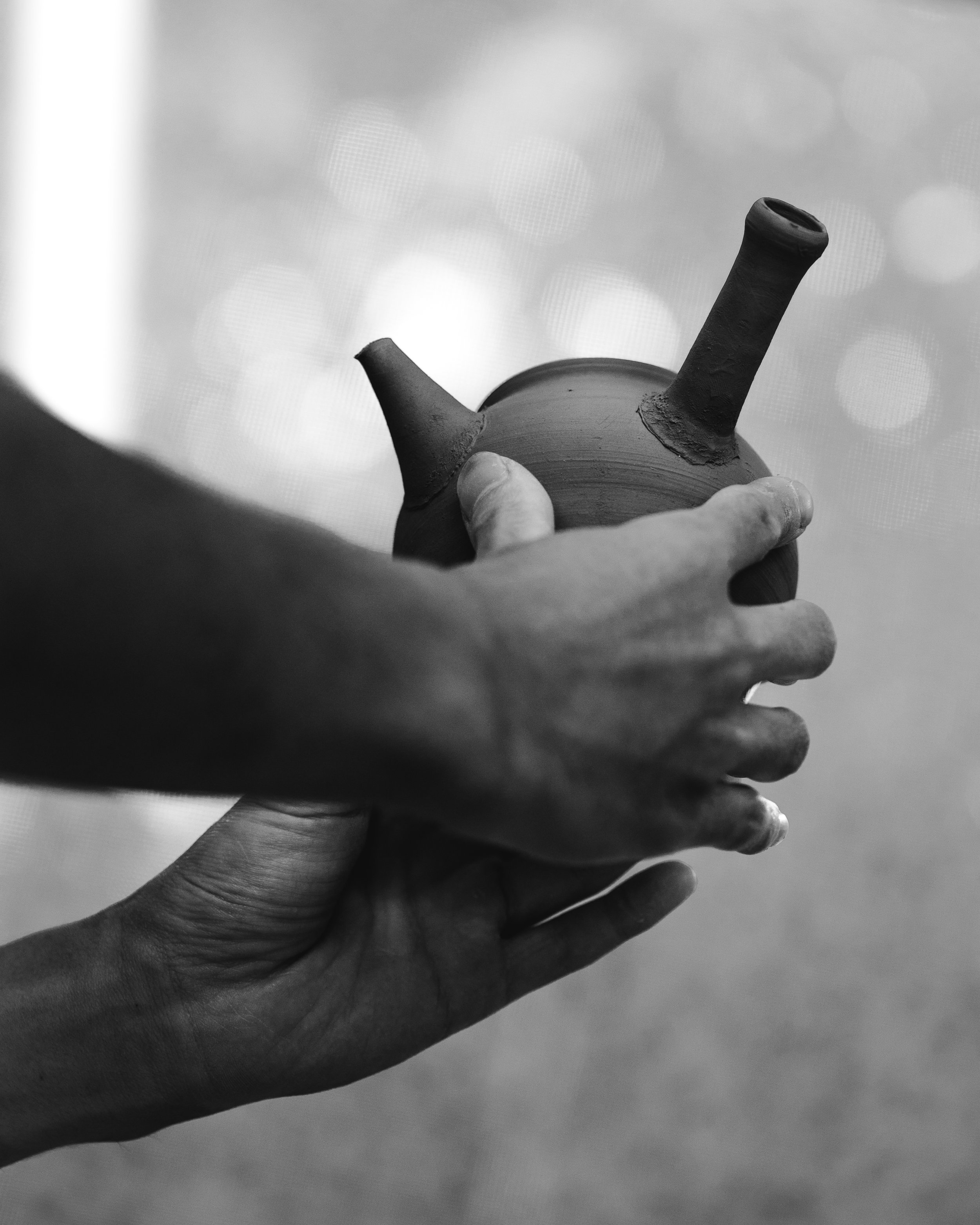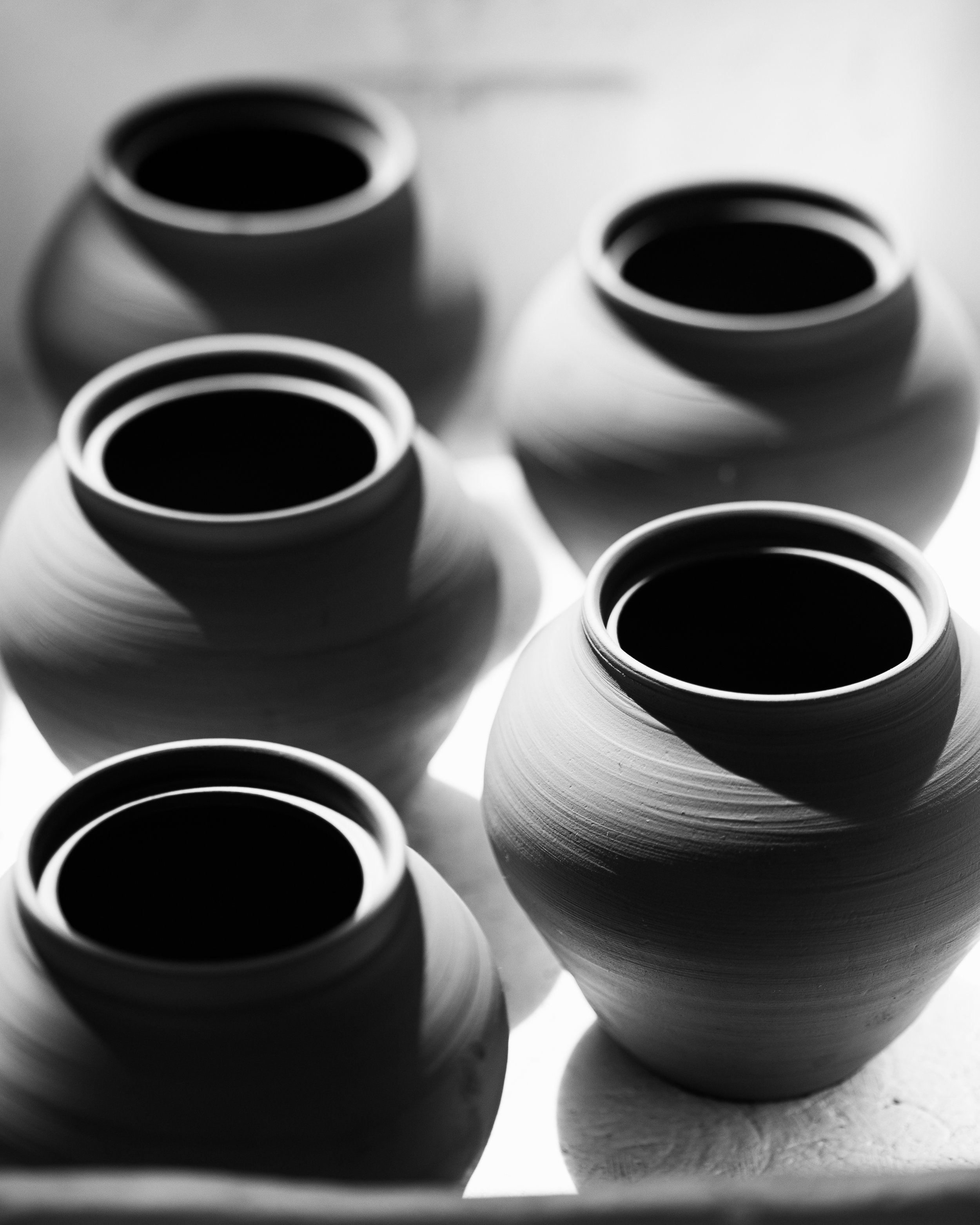Japanese Ceramicist Akira Shimojo about his willingness to challenge himself
Meet one of our first 2 Guest Artists on sentomono: Akira Shimojo, 25 from Kanagawa Prefecture, Japan. Shimojo is currently a Master of Arts student at Tokyo University of the Arts, where he is graduating in Ceramic Craft next year. His everyday tableware is created with great love for detail and a passion for the material.
sentomono初のゲストアーティスト2名のうちの1名をご紹介します。神奈川県出身の下條晃さん(25歳)です。下條さんは現在、東京藝術大学大学院美術研究科修士課程に在籍しており、来年には陶芸を専攻し卒業する予定です。彼の日常的な食器は、細部への大きな愛情と素材への情熱によって生み出されています。
What is your history with craft and ceramics?
My family was an ordinary Japanese family with no connection to crafts or ceramics. My father is a philosophy professor at a university and my mother is a housewife.
Maybe my first encounter with craft was in primary school. I found and collected pottery shards and stone tools from the Jomon period in the field in front of my house. For me, back then, Jomon pottery shards were common things that I could pick up in the fields. I remember I didn’t think anything too special about them and used them to fill in the bottom of flowerpots. Now, when I look back, I regret I didn’t collect them.
My first encounter with hands on ceramics was in my high school art class. Even then, I annoyed the teacher by saying I wanted to make a teapot!
工芸品や陶磁器との関わりについて教えてください。
私の家は、工芸や陶芸とは無縁の、ごく普通の日本の家庭でした。父は大学で哲学の教授をしており、母は専業主婦。工芸との出会いは、もしかしたら小学生の頃かもしれません。家の前の畑で縄文時代の土器片や石器を見つけては集めていました。当時の私にとって、縄文土器の破片は野原で拾える普通のものでした。あまり特別なことは考えず、植木鉢の底を埋めるのに使っていた記憶があります。今思えば、集めておけばよかったと後悔しています。私が初めて陶芸に触れたのは、高校の美術の授業でした。その時も「ティーポットを作りたい!」と言って先生を困らせました。
You study crafts at University. Is there a reason you chose this path over learning as an apprentice from a Master craftsman?
I originally went into art because I liked drawing. I didn't want to be a painter, but a manga artist. I loved "Naruto." I really enjoyed the black-and-white expression composed of strong and weak lines like in Japanese manga. That is primarily why I went to an art school and not to learn from a master craftsman.
In college, I was torn between blacksmithing and ceramics. I was torn between the two because both allow me to touch materials intuitively. In the end, I chose ceramics based on my intuition. Now I believe that my intuition was correct.
I think it was a better choice for me than being apprenticed to a master because at this school I can freely try what I want to do.
大学では工芸を学ばれているそうですね。師匠に弟子入りするのではなく、この道を選んだ理由は何でしょうか?
元々、絵を描くのが好きで美術の道に進みました。絵描きになりたいわけではなく、漫画家になりたかったんです。"NARUTO "が好きだったんです。日本の漫画のような強弱のある線で構成されたモノクロの表現がとても好きでした。だから、職人さんに教わるのではなく、美大に進学したんです。大学では、鍛冶と陶芸のどちらかを選びました。どちらも直感的に素材に触れることができるので、迷ったのですが、結局、陶芸を選びました。結局、直感で陶芸を選びました。今となっては、その直感は正しかったと思っています。この学校では、自分のやりたいことに自由に挑戦できるので、師匠に弟子入りするよりもいい選択だったと思っています。
Creative Process: How do you begin a Project? What does your process look like from the Idea to the finished piece?
For me, the process of making the work is the challenge and the art. My production starts with a willingness to challenge myself. I enjoy researching clays I have not yet used and building kilns with unusual processes.
I always start with a sketch of the planned product. Once I have a clear image, I begin to work. However, while actually touching the clay, there are times when I feel that there is a shape that would be best for the material. In those cases, I give priority to my intuition. After placing the work in the kiln, I leave it to the flames. I let go of my attachment to the image of the finished product. Then I can honestly enjoy the finished piece.
I am currently working at the Toride site of Tokyo University of the Arts, where I am researching the clay from the Toride site. Unlike the clay from famous ceramic sites in Japan, this clay is very difficult to handle. But that is why it is so much fun.
Unlike industrial products, each handmade vessel is a little bit different in size and distortion. Sometimes it is difficult to use them, but I don't throw them away just because they are difficult to use, because they are like my own children. I think it is a pleasure that can only be experienced by using something you made yourself. However, the ultimate goal is to enjoy good food and good tea. So the finished pieces are often simple tableware and utensils.
クリエイティブなプロセス プロジェクトはどのように始めるのですか?アイデアから作品完成までのプロセスはどのようなものですか?
私にとって、作品制作のプロセスこそが挑戦であり、芸術なのです。私の制作は、自分自身に挑戦する気持ちから始まります。まだ使ったことのない粘土を研究したり、変わったプロセスの窯を作ったりするのが楽しいんです。まず、必ず完成のイメージをスケッチします。完成のイメージが固まったら、制作に取り掛かります。ただ、実際に土を触っているうちに、この土にはこの形がいいなと思うことがあります。そのときは直感を優先します。窯に入れたら、あとは炎にまかせる。そのとき、完成イメージへの執着は捨てます。そうすると、素直に出来上がりを楽しめるんです。
今、私は東京藝術大学の取手遺跡で、取手遺跡の土の研究をしています。この土は、日本の有名な陶磁器遺跡の土と違って、扱いがとても難しいんです。でも、だからこそ楽しいんです。工業製品とは違い、手作りの器は大きさも歪みもひとつひとつが少しずつ違う。使いにくいこともありますが、使いにくいからと言って捨てたりしないのは、我が子のようなものだからです。自分で作ったものを使うことでしか味わえない喜びがあると思うからです。とはいえ、最終的にはおいしい料理やおいしいお茶を楽しむことが目的です。だから、出来上がった作品はシンプルな食器や道具が多いですね。
What is the most challenging part of your work?
Kiln firing. I always think about firing. When I am making the clay, turning the wheel and chopping the wood. And most of the time, I end up with something completely different from what I imagined. That is the most challenging and interesting part.
Wood-fired kilns are simple. All you do is burn wood to raise the temperature. However, simplicity is the deepest aspect of the process. There are many factors to consider, such as the type of wood used, the humidity of the ground, and the wind. But as long as the temperature rises, that's all that matters. We must also understand that we cannot completely control the flame. This does not mean that we give up controlling the flame. It is just the way it is.
仕事のやりがいは何ですか?
窯焚きです。いつも焼成のことを考えています。粘土を作っているとき、ろくろを回しているとき、木を切っているとき。そして、たいていの場合、想像していたものとはまったく違うものができあがります。そこが一番やりがいがあって面白いところです。
薪窯はシンプルです。薪を燃やして温度を上げるだけです。しかし、シンプルであるがゆえに奥が深い。使う薪の種類、地面の湿度、風など、考慮すべき要素はたくさんあります。しかし、温度が上がればそれでいいのです。また、炎を完全にコントロールすることはできないことも理解しておかなければなりません。でも、炎をコントロールすることを諦めるわけではありません。ただ、そういうものなのです。
Do you consider your work to be traditional Japanese or more modern? What influences your work?
I am thinking about the future, not the past. If we don't do something about it, beautiful nature will be lost due to the foolish actions of humans. In the past, the Japanese were grateful to nature and lived with it. Today's Japanese have forgotten that spirit and have become arrogant. It is a very sad thing.
We have to protect nature for the future, which is why I am studying the past when people still lived with nature. I want to combine this with modern technology and propose a new way of coexisting with nature for the future. For this reason, I believe that my work is both traditional and contemporary.
ご自身の作品は伝統的な日本的なものですか、それとももっと現代的なものですか?あなたの作品に影響を与えているものは何ですか?
私は過去では無く未来のことを考えています。このままでは美しい自然が人間の愚かな行為によって無くなってしまいます。昔、日本人は自然に感謝し自然と共に生きていました。今の日本人はその心を忘れ傲慢になっています。それはとても悲しい事です。私達は未来に自然を残さなければなりません。そのために私は人間がまだ自然と共に生きていた過去の事を勉強しています。そして現代のテクノロジーと融合させて、新しい自然との共存の仕方を未来に向けて提案したいのです。
そのために私の作品は伝統的でもあり現代的でもあるべきだと思っています。
Tell us about your favourite object you have at home. What is special about it?
'Mitch'. He is a plant. He is my best friend.
Mitch is a Euphorbia pineapple corn, which I bought seven years ago at a home improvement center after falling in love with it at first sight. Mitch was with me when I was first accepted to college and started living on my own. He is sensitive to cold and had to be trimmed several times in the winter because his roots rotted. That is why Mitch is so small now.
When he is healthy I put him out in the sun every morning and water him occasionally. He does not talk or dance. However, when Mitch is weak, I am constantly worried about him. My greatest happiness is that Mitch is healthy and beautiful green.
あなたの家にあるお気に入りの品物を教えてください。どのような点が特別ですか?
ミッチ」。彼は植物です。彼は私の親友です。
ミッチは、7年前にホームセンターで一目惚れして買ったユーフォルビアのパイナップルコーンです。私が大学に合格し、一人暮らしを始めた頃もミッチと一緒でした。寒さに弱く、冬は根が腐って何度もトリミングをした。だから今、ミッチはとても小さいんです。元気な時は毎朝日向に出して、時々水をあげています。しゃべらないし、踊りもしない。しかし、ミッチが弱ると、私はいつも心配でたまりません。ミッチが元気で美しい緑色をしていることが、私の一番の幸せです。











